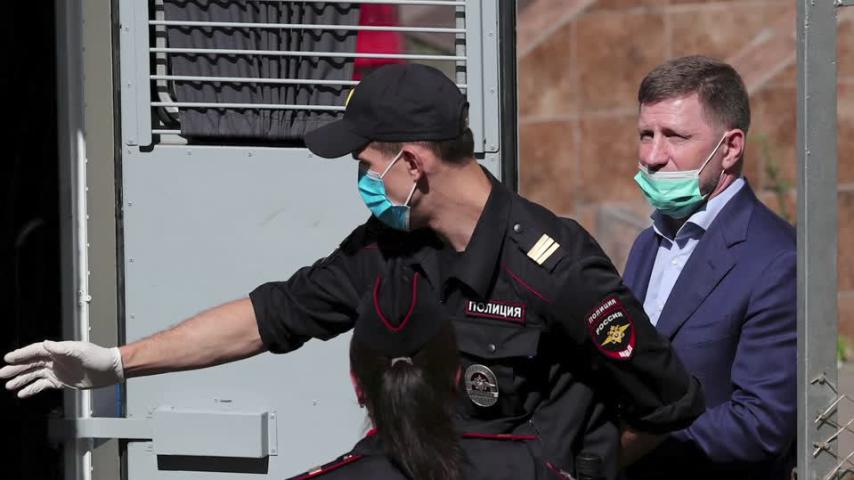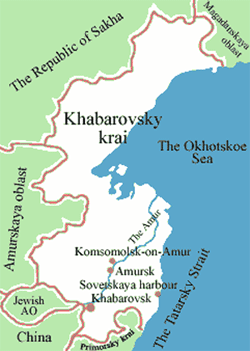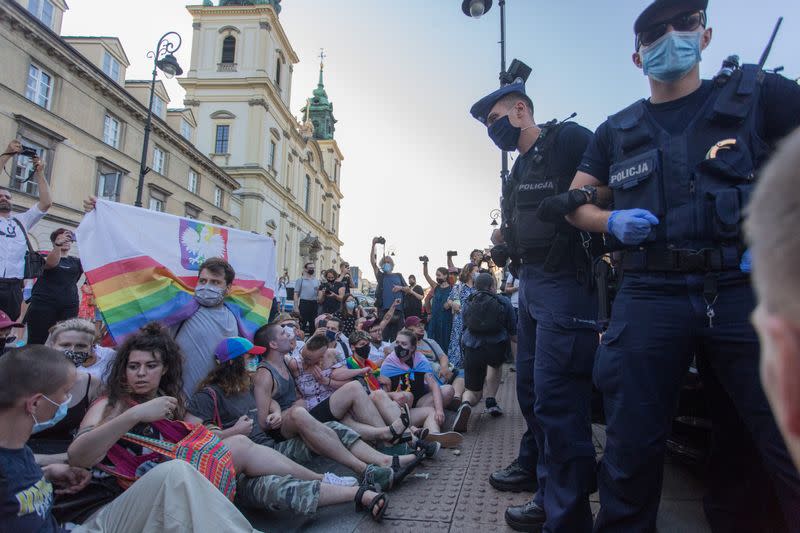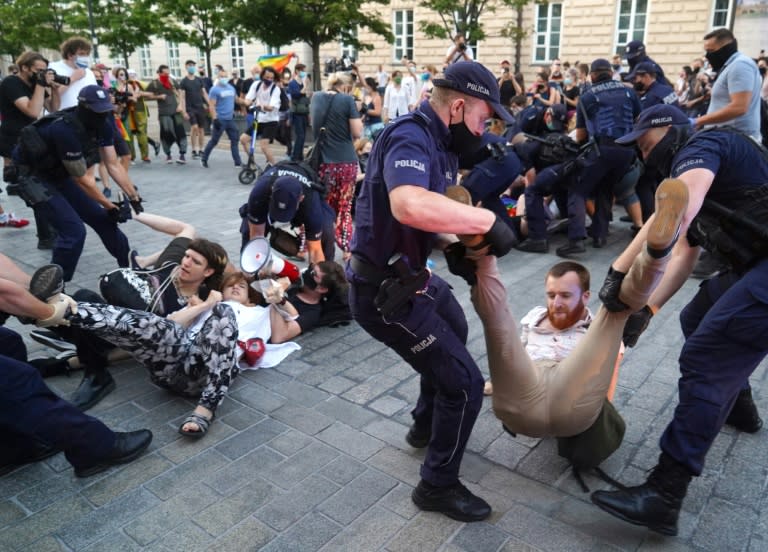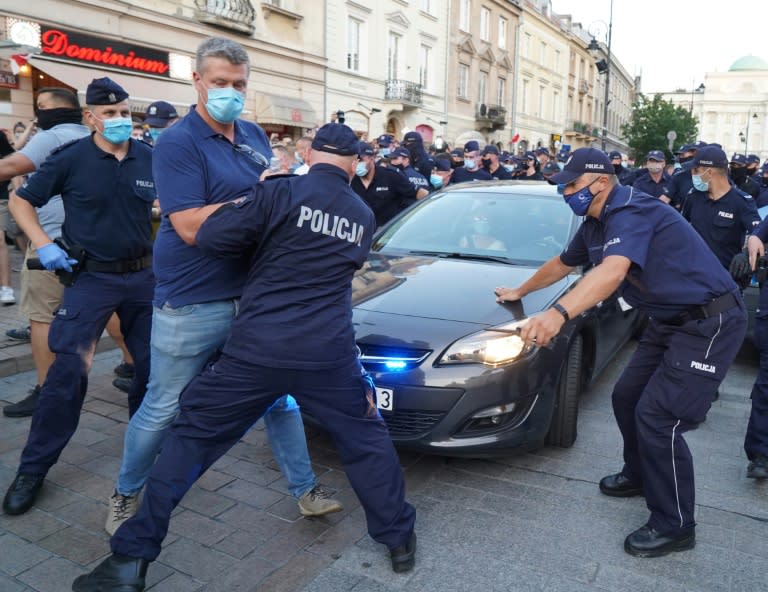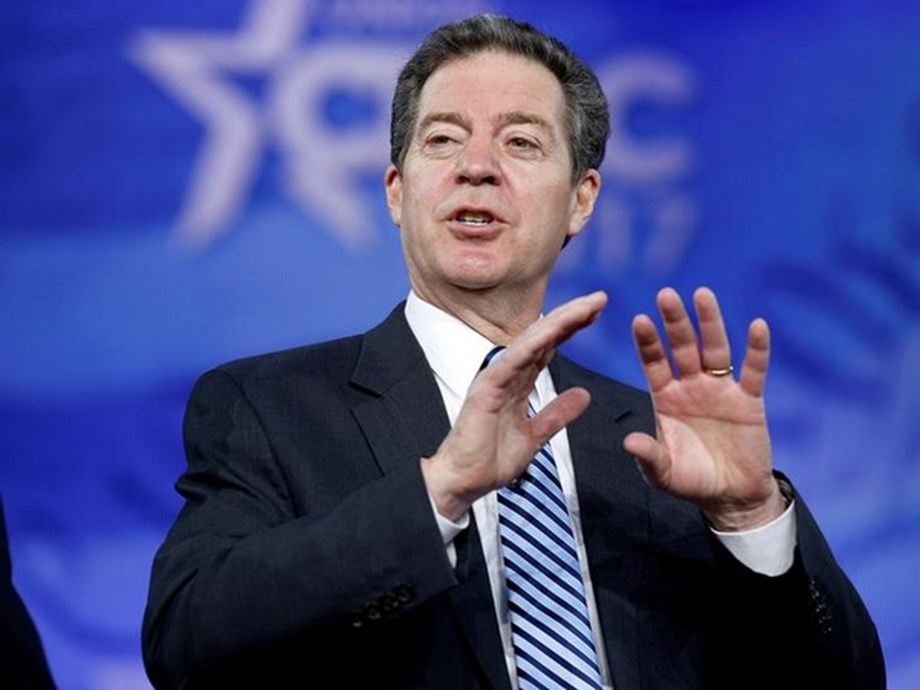Out of work and with families to feed, some Americans are lining up at food banks for the first time in their lives
WHILE MILLIONAIRE REPUBLICAN SENATORS (PLUTOCRATS) HOLD UP CONGRESSES $3 TRILLION DOLLAR RESCUE PACKAGE
WHILE MILLIONAIRE REPUBLICAN SENATORS (PLUTOCRATS) HOLD UP CONGRESSES $3 TRILLION DOLLAR RESCUE PACKAGE
LONG READ
Christopher Wilson Senior Writer, Yahoo News•August 7, 2020
As tens of millions of Americans have lost jobs due to the coronavirus pandemic, food banks across the country say they are facing an unprecedented surge in demand, comparable to a hurricane hitting the entire country at the same time.
“I’ve been in food banking for 24 years, and in my tenure I’ve never seen such a dramatic increase in need literally overnight,” said Lisa Scales of the Greater Pittsburgh Community Food Bank, referring to the initial spike in distribution in March, when the shutdowns started.
Across the country, Americans who’ve never had to rely on food assistance before are turning to local organizations for aid. In July, the Census Bureau reported that nearly 30 million Americans said they didn’t have enough to eat in the prior week, a situation that is likely to worsen since the expanded unemployment insurance of $600 per week ended last month. Food banks across the country are bracing for both another spike in food insecurity and the fact that the effects of the pandemic are likely to last until 2021 and beyond.
A number of food bank employees compared the current situation to the Great Recession of the late 2000s in terms of both length of need and impact, as the normal practice of turning to other parts of the country for support in times of a natural disaster failed in the face of a nationwide calamity.
“The best way to describe it is, we were very active through Hurricane Harvey, which devastated Houston and the surrounding area, and this is way worse than that,” said Mark Brown of the West Houston Assistance Ministries, a large food pantry in the area. “I’ve never seen this level of community-wide desperation at such an extended level.”
Like any other organization, food banks faced their own impacts of the pandemic, which kept some infected workers and older volunteers home, and required changes in procedure to implement social distancing. They changed distribution methods, setting up drive-through or no-contact pickups and starting direct-to-door delivery while coping with supply chain problems. Staffers who were used to helping residents sign up for SNAP benefits in the field set up special phone lines to deal with the influx of applicants.
“We’re very concerned,” Scales said of the expiration of federal unemployment benefits, noting that her food bank had already seen a slight increase just in the last week. “We’re anticipating higher than normal need for the next year, year and a half.”
But there was also gratitude and pride in how communities have stepped up to help their neighbors, with donations pouring in despite hard times for so many Americans. Yahoo News spoke to food banks across the country about what the last five months have been like and how they’re preparing for another potential spike as benefits that have kept many afloat expire. Their comments have been edited for length and clarity.
Natalie Jayroe, Second Harvest Food Bank of Greater New OrleansIt’s been a sprint and a marathon. Here in Louisiana we’ve had our share of natural and man-made disasters over the last decade and a half, having been through [Hurricanes] Katrina and Rita and then Gustav and Isaac and then an oil spill and an economic recession. Yet for intensity this has been the equal of any of them so far.
First we had the schools close down, so we had children losing their free and reduced breakfast and lunch. Then we had seniors who could no longer go to grocery stores, we had people quarantining who we had to get food to, and then we had mandatory stay-at-home orders and the community shut down. That was a huge shock, so now you have a community full of people who are still here, who can’t go anywhere and have totally lost the ability to care for themselves and their families. Unemployment in New Orleans topped 50 percent at some points. With the cases going up, it’s frustrating to know we’re going to be in the acute phase of disaster response at least until the end of this year.

El Paso Baptist Association volunteers hand out boxes of food on July 17. (Joel Angel Juarez/Bloomberg via Getty Images)
When people start to find us and show up at the door in an industrial part of New Orleans, it means they’ve never needed food before and they don’t understand that there’s probably a church partner in their neighborhood that they can go to. So when we had so many people showing up that we couldn’t get our tractor trailers into the warehouse, when we started to have hundreds of cars waiting outside our door, we moved that distribution to Zephyr Field, which is our baseball stadium, and now we have more than 2,000 cars there once a week waiting for food distribution, and they’ll wait five hours, six hours.
We’ve had incredibly generous community support — we’re just really the funnel through which the community takes care of itself. I can’t say thank you enough to our local community. Normally when we have disasters like this, we’ll reach out to food banks in Florida, Texas and North Carolina, where they have hurricanes — we pay it forward, because people have supported us through the downtimes we’ve had — but right now the whole country is in the same boat, so it really comes down to a local community taking care of itself, and the people here have been so generous in taking care of each other.
When people start to find us and show up at the door in an industrial part of New Orleans, it means they’ve never needed food before and they don’t understand that there’s probably a church partner in their neighborhood that they can go to. So when we had so many people showing up that we couldn’t get our tractor trailers into the warehouse, when we started to have hundreds of cars waiting outside our door, we moved that distribution to Zephyr Field, which is our baseball stadium, and now we have more than 2,000 cars there once a week waiting for food distribution, and they’ll wait five hours, six hours.
We’ve had incredibly generous community support — we’re just really the funnel through which the community takes care of itself. I can’t say thank you enough to our local community. Normally when we have disasters like this, we’ll reach out to food banks in Florida, Texas and North Carolina, where they have hurricanes — we pay it forward, because people have supported us through the downtimes we’ve had — but right now the whole country is in the same boat, so it really comes down to a local community taking care of itself, and the people here have been so generous in taking care of each other.
Cynthia Kirkhart, Facing Hunger Foodbank (Huntington, W.Va.)
It really feels like it’s been a year, when it’s been about five months. Even before West Virginia had diagnosed cases, we saw what was going to be coming and started ordering up food because we recognized that we would probably have a pretty significant increase. We currently serve about 129,000 people across 17 counties. West Virginia is a poor state in general, but the job loss we anticipated was going to increase our demand about 50 percent. When the pandemic came and the closures occurred, those estimates became true, particularly with the demand for child nutrition with schools closed.
We started seeing real delays in getting food, and the cost of that food started to really increase quite a bit. Where I buy thousands of pounds of ground beef, I never really had to pay beyond $2 a pound for it, and suddenly I was being faced with $4.87. So you can only imagine, for the families we serve or who receive SNAP benefits and are purchasing products through their retailers, lot of foods became cost-prohibitive and the benefits didn’t extend as far. We had families who were doing pretty good with managing their food budget that really had to come back to us for assistance because those dollars weren’t providing enough for the family.

New Yorkers in need receive free produce, dry goods and meat at a Food Bank for New York City distribution on July 30. (Michael Loccisano/Getty Images for Food Bank for New York City)
Things leveled off over the last month or so at about a 25 percent increase, as a lot of people overcame the challenge of getting their unemployment benefits. People got the supplemental assistance, so they were able to move forward with paying for bills and food. Now that those benefits have ended and the resolution of that is still pending, we’re expecting we’ll see an increase again. We’ve already had [to close] some of our pantries located in areas really hard hit by the virus, so we’re again challenged to go back into those communities and do mobile distribution, which is focused on safety for the food bank staff, our volunteers and those receiving the food.
I’ve been struck by how the Band-Aid we rely on to hold safety net services together has been ripped off with this pandemic. What were already really fragile systems have really been broken. I’m hoping we can continue the conversations about how we can better serve our seniors, how we can better serve our veterans and homeless population, and certainly how we can better serve our children, as many rely so heavily on those meals they receive at school.
Things leveled off over the last month or so at about a 25 percent increase, as a lot of people overcame the challenge of getting their unemployment benefits. People got the supplemental assistance, so they were able to move forward with paying for bills and food. Now that those benefits have ended and the resolution of that is still pending, we’re expecting we’ll see an increase again. We’ve already had [to close] some of our pantries located in areas really hard hit by the virus, so we’re again challenged to go back into those communities and do mobile distribution, which is focused on safety for the food bank staff, our volunteers and those receiving the food.
I’ve been struck by how the Band-Aid we rely on to hold safety net services together has been ripped off with this pandemic. What were already really fragile systems have really been broken. I’m hoping we can continue the conversations about how we can better serve our seniors, how we can better serve our veterans and homeless population, and certainly how we can better serve our children, as many rely so heavily on those meals they receive at school.
Scott Young, Food Bank of Lincoln (Neb.)
We saw a real spike in rural need when the pandemic settled in. Since then we’ve seen a spike in Lincoln too, as unemployment has continued to escalate. People have not returned to jobs. I think a lot of us back in March thought this was a 60- or 90-day inconvenience we’d be dealing with, and as it dragged on we’ve learned and come to believe this is months and months to go yet. We’re planning on a month-to-month basis, but we’re planning on doing this model of our operation through New Year’s Day, and I fully anticipate we’ll be doing it into the spring of 2021. So when we talk about returning to normal, some of our staff members talk about “This is normal and we better get used to it.”
In Lincoln in 2019, we had 5,892 people on the unemployment rolls. In June of 2020 we had 13,326. So we’ve had an earthquake, demographically speaking, of newly unemployed people and households that are going to have more month than money. Nebraska, much to our relief, has one of the lowest unemployment rates in the country. In June we were seventh [lowest], so that’s a positive sign in a roundabout way, but if you’re one of those people who are unemployed it doesn’t matter. You still have the problem of poverty and food insecurity.
A line that has been repeated around the food bank often is people saying, “I hate that I have to do this,” in terms of going through a food line. We’ve heard from people who’ve said, “I used to donate to the food bank, and now all of a sudden I’m in your line,” and I think that’s a testament to the charitable food system and the importance of supporting it. So many of us are on a pretty precarious financial edge, our economic system has been revealed as pretty fragile during the pandemic, and a lot of people are paying a stout price for it.
In Lincoln in 2019, we had 5,892 people on the unemployment rolls. In June of 2020 we had 13,326. So we’ve had an earthquake, demographically speaking, of newly unemployed people and households that are going to have more month than money. Nebraska, much to our relief, has one of the lowest unemployment rates in the country. In June we were seventh [lowest], so that’s a positive sign in a roundabout way, but if you’re one of those people who are unemployed it doesn’t matter. You still have the problem of poverty and food insecurity.
A line that has been repeated around the food bank often is people saying, “I hate that I have to do this,” in terms of going through a food line. We’ve heard from people who’ve said, “I used to donate to the food bank, and now all of a sudden I’m in your line,” and I think that’s a testament to the charitable food system and the importance of supporting it. So many of us are on a pretty precarious financial edge, our economic system has been revealed as pretty fragile during the pandemic, and a lot of people are paying a stout price for it.
Lisa Endl, Feeding America Eastern Wisconsin
We support 35 counties in Wisconsin, and during the pandemic period from March 1 to June 30 we distributed 11 million pounds of food, and that was an 85 percent increase over what we’ve done in years prior. It’s been a very strong increase, and we definitely anticipate that if the added unemployment benefits go away that increase is going to be even more.
About 40 percent of the people using pantries are using them for the first time ever. We’ve always known in our work that anyone is just one injury or one missed paycheck from relying on a pantry, and right now it’s just a huge influx. In 2019, in our service area of eastern Wisconsin, 1 in 10 people were food-insecure or didn’t know where their next meal was going to come from, and we anticipate by the end of 2020 that 1 in 7 people will be facing hunger, including an additional 77,000 children.
I was just speaking with one of our pantries that is in Milwaukee. It’s an inner-city church, and they typically just have people from that area come in once a month to pick up products. Now they’re seeing people from suburbs and outlying ZIP codes who are coming to them now for the first time, so their reach is growing as the need is growing.
Jocelyn Lantrip, Food Bank of Northern NevadaWe cover the whole northern part of the state, and we have a big surface area, about 90,000 square miles, and we were busy before the pandemic. Our monthly average, we’d serve about 91,000 people — we had a pretty significant issue with hunger already — and we saw a very staggering increase right after the shutdown. It was not unusual to approach 1,000 families at one distribution, and we had also been turning to drive-throughs and 147 partners to distribute food for us.
We saw a particular increase in our Mobile Harvest program, where we take fresh fruits and vegetables out to neighborhoods. Leading up to the crisis, we were helping about 8,900 people per month through that program. In April we helped 28,272 people. We’ve never seen numbers like this. April was our worst month — we helped 125,000 people overall. We saw a lot of people who had never received food assistance before, and they were confused and not really knowing what to do, and then we throw a bunch of other restrictions on how you can receive food. You’re in a drive-through distribution, you have to wait in a line and give your information, and the whole process is rattling to some.

Volunteers with boxes of food to take to a senior apartment building during a food distribution at Salem United Methodist Church in Shoemakersville, Pa., on July 15. (Ben Hasty/MediaNews Group/Reading Eagle via Getty Images)More
We saw somewhat of a leveling off in June, still higher than normal, but we really are expecting a huge spike next month if something doesn’t change with the benefits expiring. In our area, reported unemployment right now is about 24.9 percent. I was here during the recession and we were pretty busy during that time, but unemployment was about 14 percent. We’ve never seen anything like this, and for that many people to lose benefits we’re prepared to be very, very busy.
We’ve been trying to get as much food in the door as we can so we can be ready for August and what we might see in the next few months. No matter what happens, we’re expecting this to be a very long recovery, because we haven’t recovered from the last economic issue, at least low-income people haven’t. We’re not unique with this, but we’ve seen issues with the supply chain, as food that would take us a month will take three months or longer to get here. That’s been an issue just to stay ahead of it, so we’re really ordering food all the time. We’ve been fortunate at our food banks — we haven’t had to turn anyone away because we’ve run out of food.
We saw somewhat of a leveling off in June, still higher than normal, but we really are expecting a huge spike next month if something doesn’t change with the benefits expiring. In our area, reported unemployment right now is about 24.9 percent. I was here during the recession and we were pretty busy during that time, but unemployment was about 14 percent. We’ve never seen anything like this, and for that many people to lose benefits we’re prepared to be very, very busy.
We’ve been trying to get as much food in the door as we can so we can be ready for August and what we might see in the next few months. No matter what happens, we’re expecting this to be a very long recovery, because we haven’t recovered from the last economic issue, at least low-income people haven’t. We’re not unique with this, but we’ve seen issues with the supply chain, as food that would take us a month will take three months or longer to get here. That’s been an issue just to stay ahead of it, so we’re really ordering food all the time. We’ve been fortunate at our food banks — we haven’t had to turn anyone away because we’ve run out of food.
Jennifer Caslin, Food Bank of Central & Eastern North Carolina
We have been purchasing more food than we normally would in the past. Normally we rely on donations. In March our purchase budget for food was $500,000, and we ended up spending $2 million. For funding, the community has really stepped up during this time — we’ve been comparing it to the Great Recession because it feels very much like that. People really stepped up to give us support throughout the recession even though they had less to donate, but they knew food was a huge need.
If the recovery doesn’t continue and those additional funds aren’t extended in some form, we do expect the levels of visits from folks to get closer to what they were right at the beginning of quarantine, when our agencies were distributing as much as 150 percent higher than in pre-COVID times. Our food finder on our website, where you can go find a partner agency near you to receive help, right at the beginning of the pandemic the traffic for that site increased by 1,500 percent. We’re definitely expecting it to go back towards those levels as long as there’s not that additional support for people who still can’t go back to work.

Residents in vehicles wait for food at a Kelly Center for Hunger Relief distribution site in El Paso, Texas, on July 17. (Joel Angel Juarez/Bloomberg via Getty Images)
There’s always the chance of a weather event, so that on top of a pandemic would be pretty devastating. Thankfully, it’s looking like Hurricane Isaias wasn’t as bad as it could have been, but we’re keeping our fingers crossed that we don’t get anything worse than that this summer. We’re prepared if we do, but certainly that could make things a lot worse for people anywhere that might be impacted by a weather event.
There’s always the chance of a weather event, so that on top of a pandemic would be pretty devastating. Thankfully, it’s looking like Hurricane Isaias wasn’t as bad as it could have been, but we’re keeping our fingers crossed that we don’t get anything worse than that this summer. We’re prepared if we do, but certainly that could make things a lot worse for people anywhere that might be impacted by a weather event.
Lori Long, Community Food Bank of Eastern Oklahoma
We drove to this real small town in northeast Oklahoma. I had never been there before, and it was a stereotypical small-town food desert. They had a convenience store and some kind of a dollar store. There were very limited nutritious and fresh options because the grocery store had closed. So we set up this distribution, we were blessed to have the National Guard assisting us, and we had about a three-hour distribution. I am not kidding you, there were cars lined up the entire main street of this little town waiting to come through.
I know one of the biggest things for us that we think is going to increase need, or at least keep it at the high level, is all of the school systems deciding to go virtual. We still have a couple of systems that haven’t decided yet, but the majority have decided to stay virtual, but our kids really rely on those school meals. The other thing is looking at industry-specific impact. For example, in Oklahoma we are a heavy oil and gas economy. We also have a significant aviation industry, and of course with travel not being where it’s been in the past, it impacts both of those industries, so that’s something locally we are seeing more.
Dave Krepcho, Second Harvest Food Bank of Central Florida
I hate to even think about [the expanded unemployment benefits expiring]. That’s going to cause an immediate increase. The theme parks have reopened on a small scale, but Disney has 70,000 employees. When they’re partially open that’s tens of thousands of people without a job. Then add Universal Orlando and the other theme parks like Sea World, and then the ripple effect to all the resorts, all the hotel rooms, all the restaurants, the rent-a-car companies.
We’re a convention town, and that convention center hires thousands of people to work there, so when that hits a community like this it’s devastating economically. Thank God the stimulus checks went out, and thank God the $600 has been around, but when that’s reduced — the jobs aren’t here. There’s some job training going on, but my goodness, those openings are so few and far between, so it’s going to take months — I’ve heard some economists project that it will take 24 to 36 months to fully get back as a community. So that $600, that’s golden for these folks, and that only goes so far.
On the flip side, what I’ve seen that’s a very positive thing, we started to see a pattern of $1,200 donations. A lot of people were attaching notes to these and saying, “My wife and I got our stimulus checks and we don’t need them as much as somebody else does. Please put this to work for us.” Things like that, the community’s generosity, is really heartwarming.

